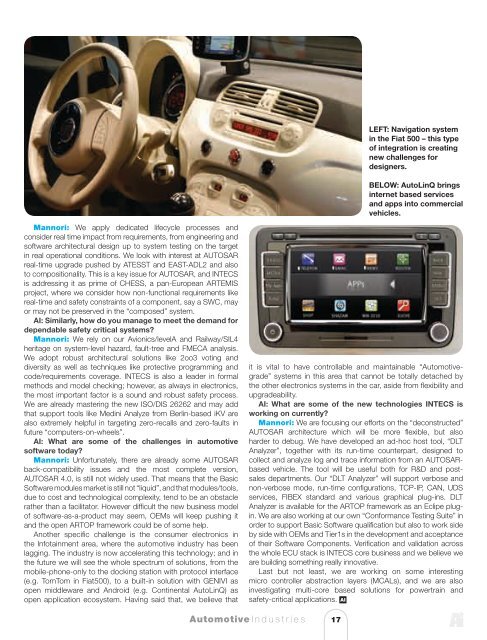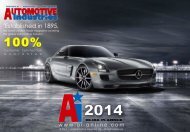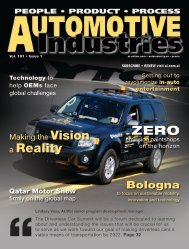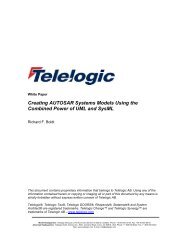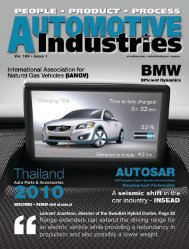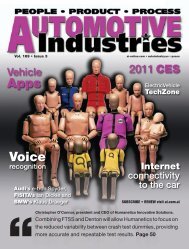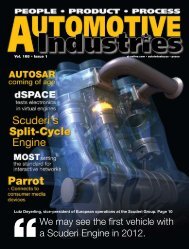engineering, AUTOSAR - Automotive Industries
engineering, AUTOSAR - Automotive Industries
engineering, AUTOSAR - Automotive Industries
You also want an ePaper? Increase the reach of your titles
YUMPU automatically turns print PDFs into web optimized ePapers that Google loves.
Mannori: We apply dedicated lifecycle processes and<br />
consider real time impact from requirements, from <strong>engineering</strong> and<br />
software architectural design up to system testing on the target<br />
in real operational conditions. We look with interest at <strong>AUTOSAR</strong><br />
real-time upgrade pushed by ATESST and EAST-ADL2 and also<br />
to compositionality. This is a key issue for <strong>AUTOSAR</strong>, and INTECS<br />
is addressing it as prime of CHESS, a pan-European ARTEMIS<br />
project, where we consider how non-functional requirements like<br />
real-time and safety constraints of a component, say a SWC, may<br />
or may not be preserved in the “composed” system.<br />
AI: Similarly, how do you manage to meet the demand for<br />
dependable safety critical systems?<br />
Mannori: We rely on our Avionics/levelA and Railway/SIL4<br />
heritage on system-level hazard, fault-tree and FMECA analysis.<br />
We adopt robust architectural solutions like 2oo3 voting and<br />
diversity as well as techniques like protective programming and<br />
code/requirements coverage. INTECS is also a leader in formal<br />
methods and model checking; however, as always in electronics,<br />
the most important factor is a sound and robust safety process.<br />
We are already mastering the new ISO/DIS 26262 and may add<br />
that support tools like Medini Analyze from Berlin-based iKV are<br />
also extremely helpful in targeting zero-recalls and zero-faults in<br />
future “computers-on-wheels”.<br />
AI: What are some of the challenges in automotive<br />
software today?<br />
Mannori: Unfortunately, there are already some <strong>AUTOSAR</strong><br />
back-compatibility issues and the most complete version,<br />
<strong>AUTOSAR</strong> 4.0, is still not widely used. That means that the Basic<br />
Software modules market is still not “liquid”, and that modules/tools,<br />
due to cost and technological complexity, tend to be an obstacle<br />
rather than a facilitator. However difficult the new business model<br />
of software-as-a-product may seem, OEMs will keep pushing it<br />
and the open ARTOP framework could be of some help.<br />
Another specific challenge is the consumer electronics in<br />
the Infotainment area, where the automotive industry has been<br />
lagging. The industry is now accelerating this technology; and in<br />
the future we will see the whole spectrum of solutions, from the<br />
mobile-phone-only to the docking station with protocol interface<br />
(e.g. TomTom in Fiat500), to a built-in solution with GENIVI as<br />
open middleware and Android (e.g. Continental AutoLinQ) as<br />
open application ecosystem. Having said that, we believe that<br />
it is vital to have controllable and maintainable “<strong>Automotive</strong>grade”<br />
systems in this area that cannot be totally detached by<br />
the other electronics systems in the car, aside from flexibility and<br />
upgradeability.<br />
AI: What are some of the new technologies INTECS is<br />
working on currently?<br />
Mannori: We are focusing our efforts on the “deconstructed”<br />
<strong>AUTOSAR</strong> architecture which will be more flexible, but also<br />
harder to debug. We have developed an ad-hoc host tool, “DLT<br />
Analyzer”, together with its run-time counterpart, designed to<br />
collect and analyze log and trace information from an <strong>AUTOSAR</strong>based<br />
vehicle. The tool will be useful both for R&D and postsales<br />
departments. Our “DLT Analyzer” will support verbose and<br />
non-verbose mode, run-time configurations, TCP-IP, CAN, UDS<br />
services, FIBEX standard and various graphical plug-ins. DLT<br />
Analyzer is available for the ARTOP framework as an Eclipe plugin.<br />
We are also working at our own “Conformance Testing Suite” in<br />
order to support Basic Software qualification but also to work side<br />
by side with OEMs and Tier1s in the development and acceptance<br />
of their Software Components. Verification and validation across<br />
the whole ECU stack is INTECS core business and we believe we<br />
are building something really innovative.<br />
Last but not least, we are working on some interesting<br />
micro controller abstraction layers (MCALs), and we are also<br />
investigating multi-core based solutions for powertrain and<br />
safety-critical applications. AI<br />
<strong>Automotive</strong> <strong>Industries</strong> 17<br />
LEFT: Navigation system<br />
in the Fiat 500 – this type<br />
of integration is creating<br />
new challenges for<br />
designers.<br />
BELOW: AutoLinQ brings<br />
internet based services<br />
and apps into commercial<br />
vehicles.


